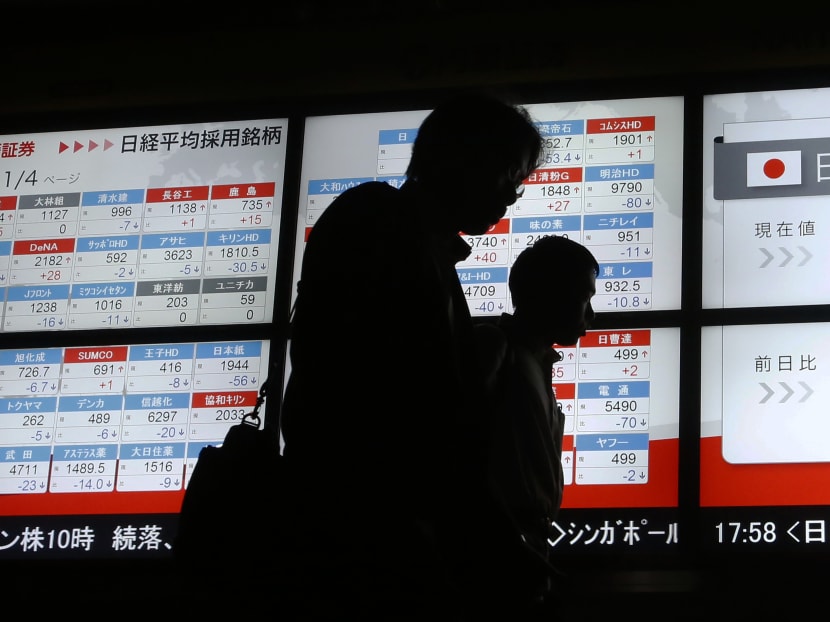Exchange Traded Funds help hedge market risks
Exchange Traded Funds help hedge market risks

People walk past an electronic stock indicator of a securities firm in Tokyo. Photo: AP
The traditional path for investors who want to invest in shares have been to select stocks in individual companies. While investors who choose the right shares may gain, that approach can be quite risky.
“Who would have expected the sharp fall in the oil price since last year and how the oil and gas stocks have been affected so badly,” said Ms Joanne Goh, DBS regional equity strategist. “Unless one has perfect foresight, it is not always true that he or she will be able to pick the right stock.”
THE ADVANTAGE OF EXCHANGE TRADED FUNDS
An alternative that many investors are turning to is Exchange Traded Funds (ETFs).
The Singapore Exchange (SGX) describes ETFs as “an open-ended investment fund that aims to replicate the performance of a published market index. It is listed and traded on a stock exchange.”
A key advantage is lower costs. “Investors pay lower management fees when compared to investing in mutual funds and unit trusts,” Ms Goh told TODAY. “Investors also pay lower fees than if he were to invest in the basket of stocks himself rather than buying an ETF.” Financial website The New Savvy said “the cost of an ETF can be one-third that of a mutual fund.”
Another benefit, said Mr Phillip Yeo, Head of Product Development & Management at Nikko Asset Management Asia, is diversification. “ETFs provide instant diversification into top quality securities. The eventual basket is representative of the market, and is periodically refreshed to ensure its currency to the market. This alleviates an investor’s needs for constant monitoring, rebalancing, and market timing. ETF investors can expect a more consistent long term growth, without the anxiety of picking the wrong individual shares,” he said.
Ms Goh also noted that “an ETF allows you to spread your risk by investing in broad-based indexes, so investments are less prone to sudden fluctuation for individual stocks.”
Another reason they’re popular, said Monetary Authority of Singapore Executive Director Merlyn Ee, is that “you can invest in a market or a basket of assets just by investing in one product.”
TYPES OF ETFS
Worldwide, according to Ms Ee, almost US$3 trillion (S$4.14 trillion) is invested in ETFs. Here in Singapore, the 87 ETFs listed on the SGX in late 2015 were worth a combined total of about US$2.9 billion. ETFs here range from conventional investments such as Singapore Bond Index ETFs and Singapore STI ETFs on through to more esoteric ones such as a Brazil Index ETF, Russia Index ETF or Asia Consumer Staples ETF. A full list is available on the SGX website.
While ETFs are designed to provide investment results that generally track the performance of an underlying index, risks can vary depending on how the ETF manager constructs the portfolio. American financial services firm State Street said there are three main techniques: full replication; optimisation-based tracking; and synthetic replication.
In full replication, State Street explained, “an ETF holds all the securities in the same weightings as its associated index.” Optimisation-based ETFs use a sampling process to create a representative or optimised portfolio of securities that closely matches the underlying index, although that process can result in a potential tracking error. Synthetic replication ETFs “attempt to replicate index returns by purchasing derivatives such as swap agreements,” so they can be more complex and have higher risks.
SELECTING AN ETF
While there are plenty of ETFs available, it is important to select the right one. As the Securities Investors Association (Singapore) noted, “depending on the structure of the ETF, some ETFs are not able to replicate the returns of the underlying asset or index as closely as others, and some ETFs may be exposed to more risks than others.”
Investors can decide on the type of investment they want, such as local shares or foreign bonds, and get full information about the ETF. They can then select the ETFs they want.
What investors should also look for, Nikko’s Mr Yeo told TODAY, is the choice of index, an ETF with a low tracking error, and trading liquidity.
Ms Goh also said it is very important to look at the “Tracking Error” for each ETF and select ones that track the underlying index very closely. “The size of the tracking error shows how well the manager has been able to track the index,” she noted. “For example if the Singapore STI is down 3 per cent in a day, and the ETF which tracks the Singapore STI is down 5 per cent, the tracking error will be too large.”
It is also important to look at the Total Expense Ratio (TER). While costs are small compared to unit trusts, Ms Goh said costs are often ignored because they are embedded in the price. “When market return is low, especially in a growth environment, choosing an ETF with low TER will help.”
INVESTING IN AN ETF
Individuals who want to invest in ETFs can use a brokerage account to buy ETFs, just like they buy shares. While ETFs themselves provide diversification, many investors invest in several types of ETFs such as stocks and bonds or domestic and international to provide greater diversification. For many investors, ETFs may provide better returns and easier diversification than selecting individual shares.





